
Simplify and Secure: A Guide to Mastering Cisco Network Automation Workflows
In today’s complex digital landscape, managing network infrastructure has become a monumental task. With the rise of hybrid work, the explosion of cloud applications, and ever-present security threats, IT teams are stretched thinner than ever. The old-school approach of manual configuration, command-line interfaces, and reactive troubleshooting is no longer sustainable. It’s time-consuming, prone to human error, and simply cannot scale to meet modern demands.
The solution lies in a strategic shift towards automation. By leveraging intelligent workflows, organizations can transform their network operations from a reactive burden into a proactive, strategic asset. This isn’t about replacing skilled engineers; it’s about empowering them to focus on innovation instead of repetitive, manual tasks.
Why Network Automation is No Longer Optional
The push for automation is driven by critical business needs. IT teams are under constant pressure to deliver services faster, enhance security posture, and ensure a flawless user experience—all while managing increasingly complex and distributed environments.
Here’s why embracing automation is essential:
- Reduces Complexity: Modern networks span on-premise data centers, multiple cloud providers, and countless remote endpoints. Automation provides a centralized way to manage policies and configurations across this entire fabric, ensuring consistency and reducing operational friction.
- Enhances Security: A manual approach to security is a losing battle. Automation allows for the rapid deployment of security policies, proactive threat detection, and even automated responses to contain threats before they can spread.
- Increases Agility: In a digital-first world, speed is everything. Whether deploying a new branch office or rolling out a new application, automated workflows can reduce deployment times from weeks to mere hours, giving your business a competitive edge.
- Minimizes Human Error: Even the most experienced engineers can make mistakes. A single typo in a configuration file can lead to significant downtime. Automation eliminates configuration drift and ensures that changes are implemented consistently and correctly every time.
Unlocking Efficiency with a Unified Automation Strategy
Effective network automation is not about a single product but an integrated ecosystem that works together. It involves bringing simplicity, security, and visibility under one cohesive management strategy.
Cloud-Managed Simplicity:
For organizations seeking streamlined operations, cloud-managed networking platforms like Cisco Meraki provide automation out of the box. From a single dashboard, administrators can configure, monitor, and troubleshoot thousands of devices across multiple sites. This radically simplifies tasks like Wi-Fi deployment, SD-WAN configuration, and security policy enforcement, freeing up valuable IT resources.
Intent-Based Control for Campus and Branch:
For more granular, on-premise control, intent-based networking solutions like Cisco Catalyst Center are a game-changer. Instead of manually configuring individual devices, you define your desired business outcome—your “intent.” For example, you can create a policy that states “all IoT cameras must be isolated on a specific network segment.” The system then automatically translates that intent into the necessary network configurations across all relevant switches, routers, and access points.
Proactive Security and Threat Response:
Security automation is a critical piece of the puzzle. Platforms like Cisco XDR (Extended Detection and Response) correlate threat intelligence from multiple sources—including your network, endpoints, cloud environments, and email—to identify sophisticated attacks. More importantly, they enable automated responses. If a compromised endpoint is detected, the system can automatically quarantine it from the network to prevent lateral movement, all without human intervention.
Automated Troubleshooting and Visibility:
One of the most time-consuming tasks for any network team is troubleshooting performance issues. Is the problem the application, the local network, the ISP, or the cloud provider? Tools that provide deep visibility, such as Cisco ThousandEyes, automate this diagnostic process. They can pinpoint the exact source of a problem, providing actionable data to resolve issues faster and proactively monitor the digital experience for every user.
Actionable Security Tips: Your First Steps into Network Automation
Getting started with automation can feel daunting, but it doesn’t have to be. The key is to start small, target high-impact areas, and build momentum.
Identify a Repetitive Pain Point: What is the one manual task your team hates doing most? Is it onboarding new devices, updating ACLs, or performing software upgrades? Target this “low-hanging fruit” for your first automation project to demonstrate value quickly.
Leverage the Tools You Already Have: Before investing in new platforms, explore the automation capabilities within your existing Cisco infrastructure. Both Meraki and Catalyst Center have powerful, built-in automation features that you can start using today.
Focus on Outcomes, Not Just Tasks: Shift your mindset from “how do I configure this VLAN?” to “what is the business outcome I need to achieve?” This intent-based approach is the foundation of modern automation and ensures your efforts are aligned with strategic goals.
Automate Security Policy Enforcement: Security is a perfect place to start. Create an automated workflow to ensure consistent security policies are applied to all new devices that join the network. This provides immediate and significant security benefits.
Build and Expand: Once you have a few successful automation workflows running, use that success to gain buy-in for broader initiatives. Gradually expand your efforts to include more complex processes like multi-domain policy and proactive network assurance.
Ultimately, network automation is the key to building a more resilient, agile, and secure infrastructure. By moving away from manual, task-by-task management, you empower your IT team to become a true engine for business innovation and growth.
Source: https://feedpress.me/link/23532/17181438/cisco-workflows-live








